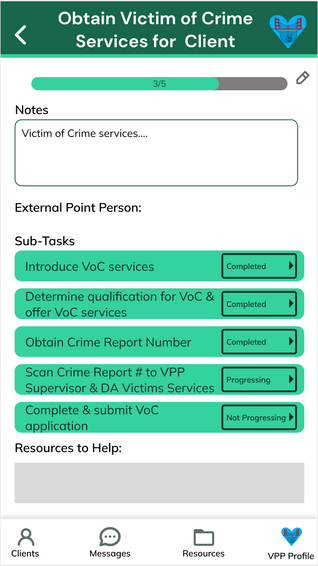
WrapApp
I led the design of WrapApp, a trauma-informed care coordination tool that helps survivors of violent crime access personalized recovery plans and critical resources after hospital discharge.
The Challenge:
For victims of violent crime, the moment after surgery is not the end of the trauma but the beginning of a long and often isolating recovery. Patients frequently lose jobs, housing, and stability. At UCSF, we learned that while these patients received world-class medical care, many left the hospital with little support for the emotional, legal, and logistical challenges that follow.
Care workers, dedicated, compassionate professionals, were trying to help. But they were managing dozens of cases at once, tracking each client’s care plan by hand, and coordinating communication through a patchwork of texts, calls, spreadsheets, and folders. Victims were falling through the cracks. Not because no one cared, but because the system wasn’t built to hold them.
The People:
Our team embedded with UCSF’s trauma recovery team, shadowing care workers, nurses, and patients to understand their pain points. We heard stories of miscommunication, missed follow-ups, and survivors feeling lost in the system.
Care workers described late-night texts from patients in crisis, varying resource usage between care workers, and a constant feeling of being reactive instead of proactive. They needed a tool that helped them deliver the care they were trained for, without adding more administrative burden.
Victims needed something even simpler: a lifeline. A way to stay connected to help, without having to chase it.
The Process:
We co-designed side-by-side with the UCSF trauma team, iterating on workflows and prototyping interfaces based on real cases. Our guiding principle was simplicity, because trauma survivors and their care workers don’t need more complexity.
From those interviews and iterations, WrapApp was born: a lightweight, trauma-informed mobile platform designed to connect care workers and clients in the critical weeks after discharge.
The Solution:
WrapApp is an iOS-based tool built for both sides of the recovery relationship. For care workers, it offers an organized dashboard to track each client’s progress, manage care plans, and schedule follow-ups. For clients, it provides:
A built-in, personalized care plan
One-touch access to call or message their care worker
A bank of vetted local resources: housing, legal aid, mental health, employment opportunities, and more
Appointment reminders, medication notes, and a simplified timeline of their recovery
Unlike traditional patient portals, WrapApp is purpose-built for trauma recovery. It focuses not just on information, but on presence, making sure clients feel supported even outside the hospital walls.
Why It Matters:
Violent crime doesn’t just hurt bodies, it disorients lives. WrapApp provides a bridge back to stability. It’s what happens when you design not just for recovery, but for dignity.
Photos of the Journey








